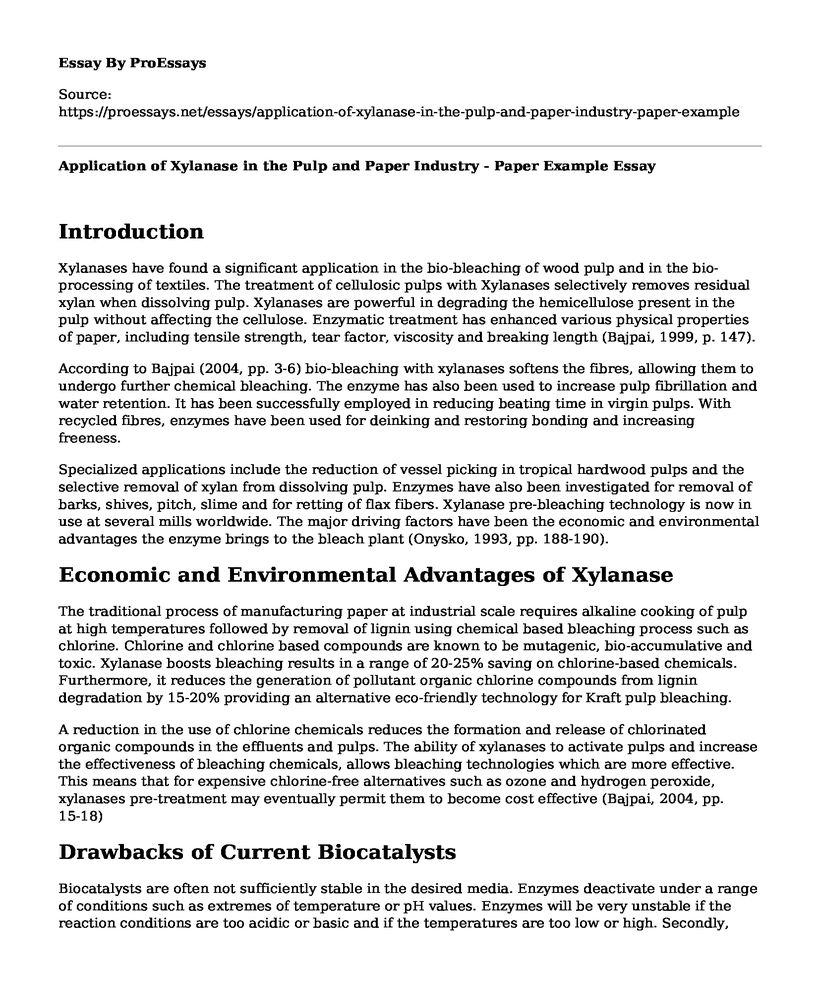Introduction
Xylanases have found a significant application in the bio-bleaching of wood pulp and in the bio-processing of textiles. The treatment of cellulosic pulps with Xylanases selectively removes residual xylan when dissolving pulp. Xylanases are powerful in degrading the hemicellulose present in the pulp without affecting the cellulose. Enzymatic treatment has enhanced various physical properties of paper, including tensile strength, tear factor, viscosity and breaking length (Bajpai, 1999, p. 147).
According to Bajpai (2004, pp. 3-6) bio-bleaching with xylanases softens the fibres, allowing them to undergo further chemical bleaching. The enzyme has also been used to increase pulp fibrillation and water retention. It has been successfully employed in reducing beating time in virgin pulps. With recycled fibres, enzymes have been used for deinking and restoring bonding and increasing freeness.
Specialized applications include the reduction of vessel picking in tropical hardwood pulps and the selective removal of xylan from dissolving pulp. Enzymes have also been investigated for removal of barks, shives, pitch, slime and for retting of flax fibers. Xylanase pre-bleaching technology is now in use at several mills worldwide. The major driving factors have been the economic and environmental advantages the enzyme brings to the bleach plant (Onysko, 1993, pp. 188-190).
Economic and Environmental Advantages of Xylanase
The traditional process of manufacturing paper at industrial scale requires alkaline cooking of pulp at high temperatures followed by removal of lignin using chemical based bleaching process such as chlorine. Chlorine and chlorine based compounds are known to be mutagenic, bio-accumulative and toxic. Xylanase boosts bleaching results in a range of 20-25% saving on chlorine-based chemicals. Furthermore, it reduces the generation of pollutant organic chlorine compounds from lignin degradation by 15-20% providing an alternative eco-friendly technology for Kraft pulp bleaching.
A reduction in the use of chlorine chemicals reduces the formation and release of chlorinated organic compounds in the effluents and pulps. The ability of xylanases to activate pulps and increase the effectiveness of bleaching chemicals, allows bleaching technologies which are more effective. This means that for expensive chlorine-free alternatives such as ozone and hydrogen peroxide, xylanases pre-treatment may eventually permit them to become cost effective (Bajpai, 2004, pp. 15-18)
Drawbacks of Current Biocatalysts
Biocatalysts are often not sufficiently stable in the desired media. Enzymes deactivate under a range of conditions such as extremes of temperature or pH values. Enzymes will be very unstable if the reaction conditions are too acidic or basic and if the temperatures are too low or high. Secondly, very few biocatalysts exist for the desired reactions from available substrates to target products. Known biocatalysts are either not well characterized, or at least not commercially available. Lastly, development cycles for biocatalysts are too long for new and improved biocatalysts (Bommarius and Riebel-Bommarius, 2007).
References
ADDIN EN.REFLIST Bajpai, P. (1999). Application of enzymes in the pulp and paper industry. Biotechnology progress, 15(2), 147-157.
Bajpai, P. (2004). Biological bleaching of chemical pulps. Critical reviews in biotechnology, 24(1), 1-58.
Bommarius, A. S., & Riebel-Bommarius, B. R. (2007). Biocatalysis: Fundamentals and Applications: Wiley.
Onysko, K. A. (1993). Biological bleaching of chemical pulps: a review. Biotechnology advances, 11(2), 179-198.
Cite this page
Application of Xylanase in the Pulp and Paper Industry - Paper Example. (2022, May 22). Retrieved from https://proessays.net/essays/application-of-xylanase-in-the-pulp-and-paper-industry-paper-example
If you are the original author of this essay and no longer wish to have it published on the ProEssays website, please click below to request its removal:
- Paramedic Retrospective Analysis
- Essay Sample on Similarities and Differences Between a Sheep and a Fetal Pig Heart
- Essay Example on Ivory Trade: Destruction of Africa & Elephants
- Essay on Island Species Richness: Measuring Time-Based Taxonomic Efforts
- Domestication: Taming Animals & Plants for Resources - Essay Sample
- Paper Example on Sharks & Teleosts: Similarities & Differences
- Free Essay Sample on Natural Capital: Essential for Human Survival







